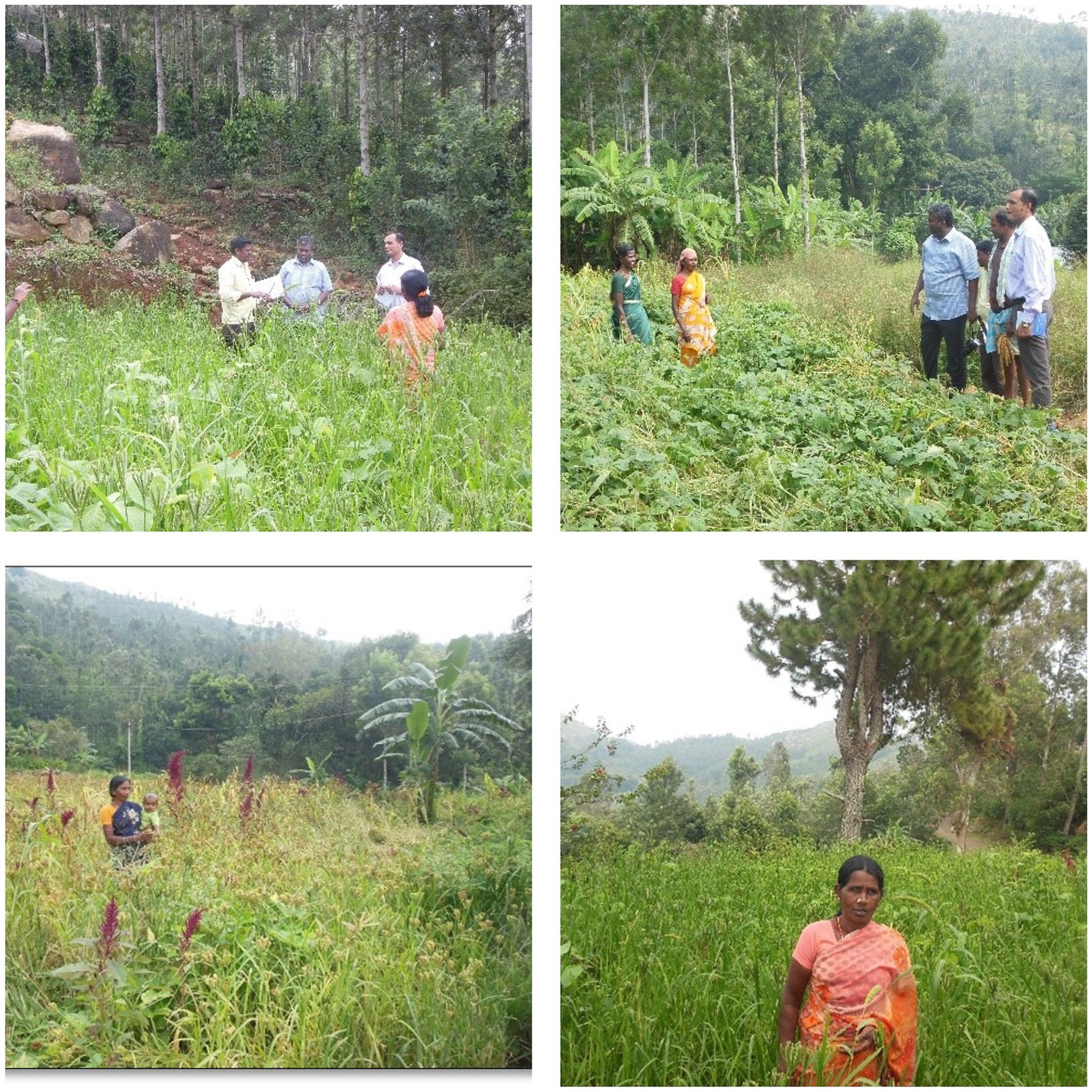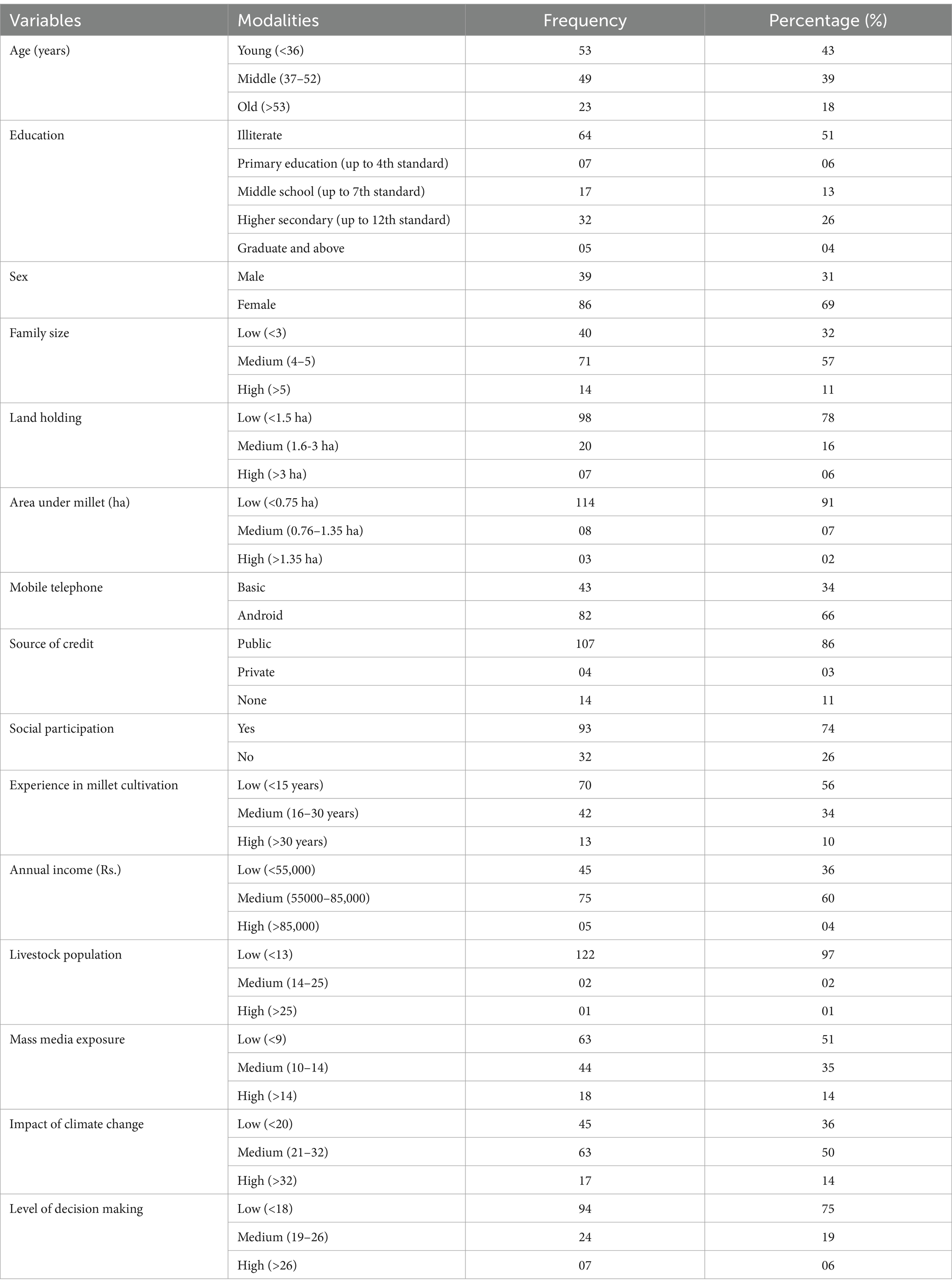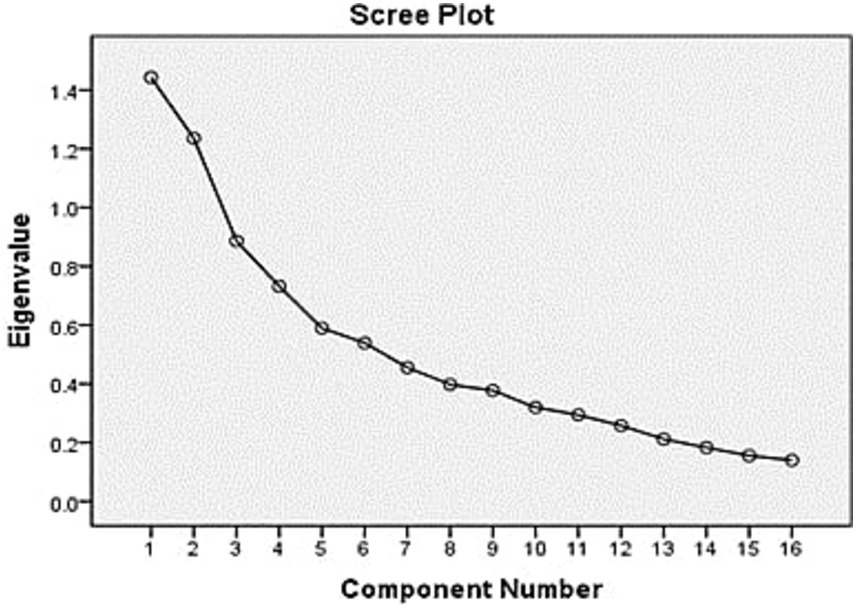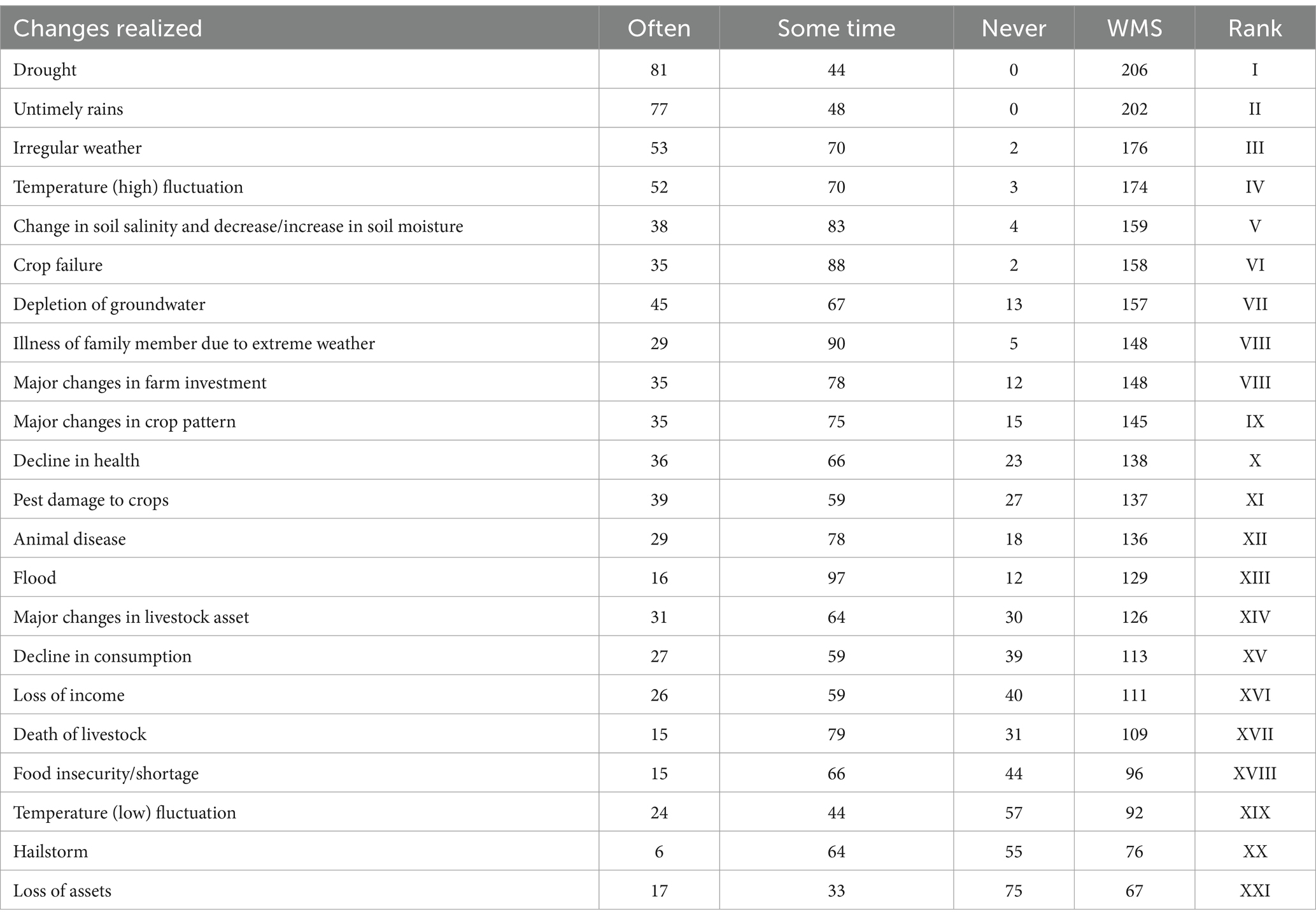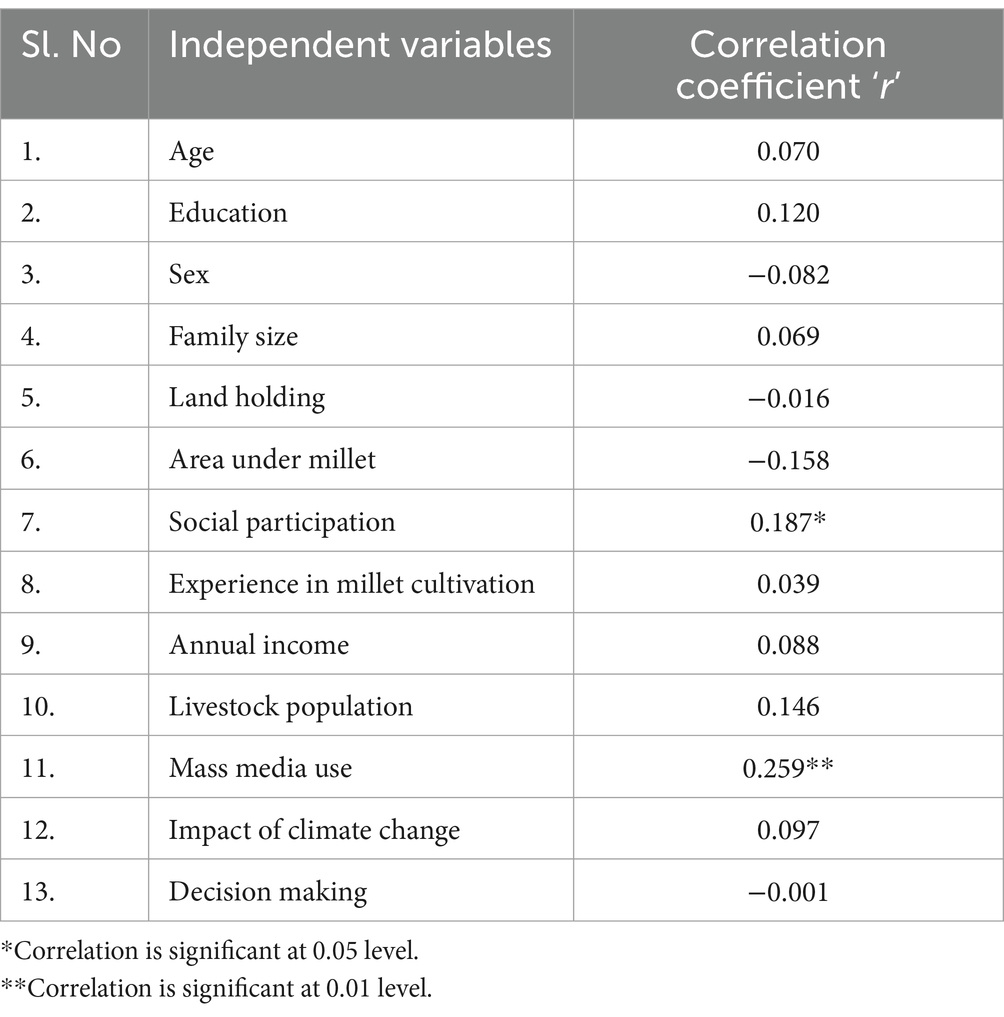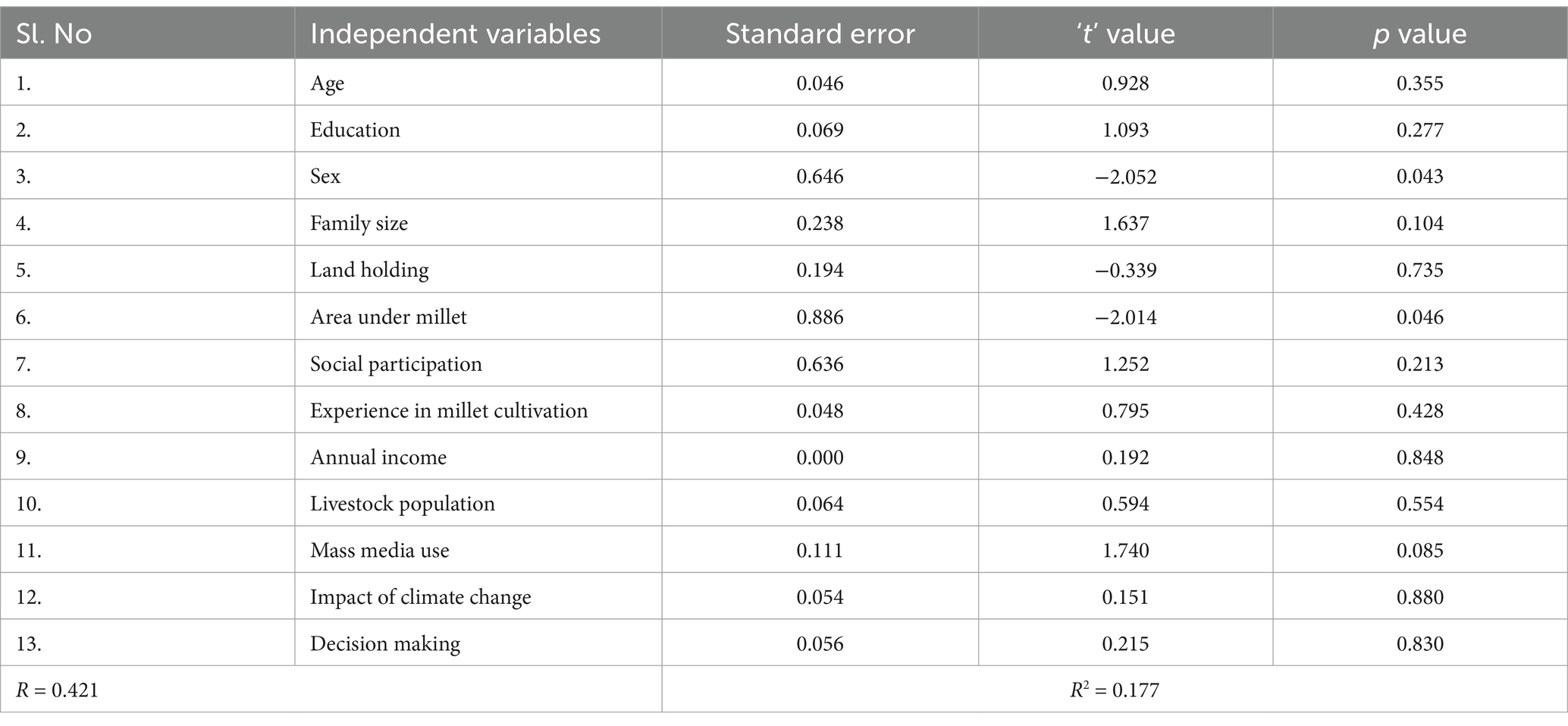- 1Indian Council of Agricultural Research-Indian Institute of Millets Research, Hyderabad, India
- 2M. S. Swaminathan Research Foundation, Chennai, Tamil Nadu, India
Climate change has a diversified impact on the accessibility to resources and maintaining food security for the growing population. In this era, climate-resilient crops such as millet have greater importance and impact on the food security of the nation. Millet cultivation in tribal areas of India presents a unique example of resilience in response to climatic variability. The research was conducted in the Kolli Hills of the Namakkal district in the state of Tamil Nadu to study the tribal farmers’ perception of climate change. Data were collected from 125 tribal farmers from five villages using a multistage random sampling method and a verified semi-structured interview schedule. Both qualitative and quantitative data were collected for analysis with different statistical tools. The majority of tribal farmers were found to be in the young age, with a high level of illiteracy and had less than 1.5 hectares of land with low mass media utility and limited decision-making ability. It was revealed that in recent years occurrences of drought, untimely rains, temperature fluctuations, and irregular weather conditions have increased. Most of the tribal farmers perceived that climate change substantially impacts low-resourced farmers’ ability to secure their livelihoods. Social participation and mass media utilization were positively correlated with tribal farmers’ perception of climatic variability. Scientific institutional knowledge and local community knowledge must be integrated with the farmers’ experiences of climate change to enable them to minimize the effect of climate change on millet production and develop a strategy that improve production under future climate scenarios. The study recommends the integration of traditional millet farming practices with modern agricultural techniques as well as the need for targeted policies that strengthen institutional support, market access, and capacity-building initiatives for tribal farmers.
1 Introduction
Agriculture plays a major role in promoting rural development, food security, poverty alleviation, and economic progression. The agriculture sector is the main source of income for almost 2.5 billion people who reside in developing countries (Maja and Ayano, 2021). Agriculture and allied sectors play a critical role in sustaining livelihoods and promoting prosperity (Alston and Pardey, 2014). Climate change, a major challenge of the twenty-first century, significantly impacted the agriculture, primary source of food, feed, and fiber. Climate change effects are anticipated to vary geographically, influenced by local weather patterns, economic capacity, and technological advancements (Kogo et al., 2021; Yang and Hamori, 2023). The Food and Agricultural Organization (FAO) of the United Nations (UN) stated that climate change has an impact on the four pillars of food security (availability, access, utilization, and stability) either directly or indirectly (Affoh et al., 2022). Significant negative effects of climate change on food production and distribution could result in an increase in the number of undernourished people in 2080 by up to 170 million worldwide by 2080 (Josef and Tubiello, 2007). These impacts, such as changing weather patterns and increased extreme events, lower productivity (Alston, 2015). The natural structure and nutritional composition of crops can be disrupted by irregular rainfall and high temperatures, resulting in lower crop quality including horticulture and agriculture and nutritional deficits (He et al., 2020). Impacts of climate change, including rising temperatures, prolonged droughts, severe storms, warming oceans, and recurrent floods and landslides, reduce agricultural productivity globally and threaten food security (IPCC, 2022). Climate change jeopardizes food access for vulnerable populations, leading to systemic breakdowns in distribution and disruptions in livestock, crop, and fisheries production due to global warming, droughts, floods, and unpredictable precipitation (O'Neill et al., 2022). The Global Food Crisis Report 2023 stated that factors such as climate change, economic shocks, geopolitical upheaval, and extreme weather events contributed to increase all led to the rise in food insecurity and the global food crisis in 2022 (Amiraslani and Dragovich, 2023). Food security is fundamental to social stability, economic growth, and national security, directly impacting public wellbeing and livelihoods (Clapp, 2020). Integrating local community knowledge with climate change adaptation strategies is crucial for empowering communities and decision-makers to develop approaches that enhance agricultural productivity under future climate conditions (Mugabe et al., 2024).
The world’s population is growing rapidly, which means that more food must be produced. The focus has to be shifted to planting climate-resilient crops like millets, which are well known for their resilience to environmental stress, to enhance food security amidst extreme weather events (Lone et al., 2020). In India, rained agriculture, which supports 60% of the livestock population of the country and provides employment to approximately 50% of the rural labor force, largely relies on millet cultivation. Although millets are generally considered pest-resistant crops, conventional farming methods can still attract various pests. More often than not, storage pests do not affect millets (Bragg et al., 2016). Millets are a sustainable option due to their ability to adapt to climate change, which can also help small-scale farmers by increasing their income and diversifying the food supply. According to the 2011 Census, the tribal population size is 10.42 million (Kalita, 2017). It accounts to 8.6% of the total population (104 million) and 11.3% in the total rural population of India; 90% of the tribal population live in rural areas and 10% in urban areas. For their subsistence, indigenous people mostly engage in agriculture, raising livestock, and gathering forest products, and several modifications are anticipated in these commercial endeavors. The tribal farming groups in Tamil Nadu cultivate a genetically varied pool of minor millet types to suit their subsistence food needs. However, there is a very limited understanding of climate vulnerabilities and how the intersection of socio-economic, personal, and agroecological factors that shape tribal farmers’ perceptions of climate change and their adaptation strategies. It is essential to examine existing farming practices, local knowledge, and the socio-economic context, coupled with market perspectives, to understand how millet farming contributes to sustainable tribal agriculture and livelihood security. The current study was conducted among tribal households in the Namakkal district of Tamil Nadu, specifically in the Kolli Hills, to understand how farmers perceive climate variability and its effects, the depletion of natural resources, and their capacity to adapt and manage these challenges. The results will provide insights into how environmental changes affect farmers’ food and livelihood security and help tribal millet farmers progress toward more informed and fair development.
2 Materials and methods
This study encompasses mixed research methods including both qualitative and quantitative where data were collected through a literature review and survey, respectively. Reviewing of published literature focused on climate change variability, its effects, and adaptation and mitigation strategies used in agriculture to collect qualitative data. Quantitative data were directly collected from farmers to explore their perception of climatic variability.
2.1 Area of the study
The Kolli Hills located in Tamil Nadu, South India, in the Namakkal District (78°17′05″E to 78°27′45″E and 11°55′05″N to 11°21′10″N), are low-ranging hills spread over an area of 441.41 km2. It is situated at an altitude ranging from 1,000 to 1,300 m above mean sea level. The Kolli Hills contains high-rising peaks and ravines. It is a fertile pocket in the Namakkal district. The place is inhabited by a group of tribals known as the Malayalis who are supposed to have migrated from the plains of Kanchipuram and settled in various hill ranges of the Eastern Ghats including the Kolli Hills about five centuries ago. The Kolli Hills is located in the extreme eastern part of the Namakkal district of Tamil Nadu. It has a tribal population that accounts for 68.34% of the total tribal population (57,059) in the district (Swaminathan, 2015). The agro-metrological statistics of the last 10 years (Table 1) show that yearly rainfall fluctuated significantly between 870 and 1,200 mm, with good rainfall supporting millet cultivation to achieve higher production of up to 2.00 t/ha in 2015. In contrast, yield declined below 2.00 t/ha in 2022 and 2023 as temperatures rose above 29°C, and the same was true during the drought. It indicates that farming, including millet growing, is similarly affected by climate change in the research areas. Both primary and secondary data were used for the study. Secondary data were collected from the published reports of the Government of India, reports of the Directorate of Economics and Statistics of the Government of Tamil Nadu, and State Revenue Authorities at district, block, and village levels. For the collection of primary data, the study adopted a multi-stage random sampling method for the selection of sample villages and households. The size of the sample for the study is 125 tribal households. Survey schedule and interview method were employed to collect primary data from the tribal households. Collected data were analyzed with appropriate statistical tools like averages, percentages, principal component analysis, cross-tabulation, and diagrammatical representation.
2.2 Sampling of the study
Millet farmers were the target respondents for the study because of their long experience in its cultivation and consumption and in understanding climate variability. Five tribal villages were selected: Palapadi, Aleripatti, Orpuram, Ettadiparai, and Pellakadu in the Kolli Hills of the Namakkal district in the Tamil Nadu state of India. The location was purposefully chosen because of its intensive millet cultivation and the majority of the population were tribals, dependent on agriculture and forest resources for their livelihood. Based on the various socioeconomic, agroecological, and environmental characteristics of the study area, these communities were chosen with the help of agricultural extension officials. The respondents were selected randomly to avoid bias wherein all the households from different villages had an equal chance of being selected. The sample of respondents was drawn from all the categories of farmers’ socioeconomic status, including an equal number of male and female farmers. In addition to this, certain criteria like their cooperative nature of interacting with outsiders and data sharing and their good communication behavior were also one of the points for their selection. The list of target farmers was drawn from the village administrative office Gram panchayat of each village. These lists were used to draw respondents randomly, which were sampled during the survey for more robust statistical analysis. Respondents both male and female, living in the selected villages, constituted the study sample population. Therefore, a total sample of 125 farmers were selected randomly from the five villages (Figure 1). A total of 125 surveys were administered to the heads of households, with 25 households sampled from each of the five selected villages (Figure 2).
2.3 Instruments for data collection
A semi-structured interview schedule was developed for data collection based on a literature review and empirical observations. It was validated by experts and pre-tested with 10 respondents representative of the sample and not included in the study to ensure the questions were effective and easy to understand. The response from pre-testing helped refine and re-structure the final data collection schedule. Accordingly, the schedule was finalized with the necessary modifications. The survey was administered by the principal investigator (PI) and co-principal investigators (Co-PIs) along with project technical staff to collect data. A total of 15 socio-personal and agro-economic variables were selected (Table 2) and categorized using the equal class intervals method for interpretation. This approach was also used in similar studies by Antwi-Agyei et al. (2021) and Awazi et al. (2023). A total of 16 statements with 5-point continuum questions using the Likert scale (Likert, 1932) were adopted to understand the farmers’ perception about the realization of climatic variability, its impact, and their needs in agriculture as followed by Mishra et al. (2021) in their study. Likert scale provides a quantitative measure of subjective experiences, making it ideal for analyzing complex variables such as opinions or attitudes. Its simplicity and ease of understanding also make it suitable for a broad range of respondents.
2.4 Data collection and analysis
The study source from the respondents conducted a survey using personal interviews as it allows for in-depth individual responses for quantitative data collection and need-based facilitative group discussions (FGDs) as FGDs facilitated group dynamics and consensus building, and empirical observations provided contextual insights and empirical observations for qualitative data collection. As the majority of the respondents were illiterate, primary data were collected personally to ensure accurate and detailed responses. The subject and purpose of the study were explained at the beginning of conducting the interviews. They were requested to share their perceptions of the statements of each item of the schedule. Sometimes, the respondents were not able to give the response easily due to their illiteracy and lack of clear understanding of the subject. Therefore, they were facilitated to obtain realistic responses using FGDs, which were organized three times in each village and cross-checked with other respondents’ groups. Thus, such respondents were interviewed personally by facilitating them with the subject knowledge so that they were able to give the responses. This approach enabled the collection of data, particularly on respondents’ perceptions and understanding of climate variability. Yeleliere et al. (2023) also followed a similar methodology in their study. The climate change impact experienced by farmers’ data was collected on a three-point continuum, viz., Often, Sometimes, and Never with a score of 2, 1, and 0, respectively. These statements were further ranked on the basis of weighted mean score (WMS). The farmers’ perception data were quantified on a 5-point continuum, i.e., strongly agree, agree, undecided, disagree, and strongly disagree assigning 5, 4, 3, 2, and 1 scores, respectively, and were ranked based on the weighted mean score (WMS). The correlation and regression between the independent variables and farmers’ perception of climate variability were also reported. Socio-personal and agro-economic status of the respondents was analyzed using descriptive statistics like mean and standard deviation along with frequency and percentage. Support of secondary data on agro-metrology was also taken. The secondary data were sourced from government reports, the Indian Meteorology Department (IMD), agricultural surveys, and relevant research studies. These credible sources provided a broader context for the study and added depth to the analysis. By comparing the trends and patterns observed in the secondary data with the primary data collected through surveys and interviews, we were able to validate key findings and ensure consistency in the results.
2.4.1 Principal component analysis (PCA)
A total of 16 statements regarding farmers’ perceptions of climatic variability and their requirements in cultivation and agriculture of millets were examined. Principal component analysis (PCA), a statistical approach, was used to narrow down the 16 statements to a handful based on their relative importance. These statements were subjected to Varimax in PCA and had a 16×16 variable matrix of correlation coefficients. The statements are also inter-correlated. Inter-correlating the variables is important because it helps identify relationships and patterns among them, showing how one variable may influence or be associated with another. This process is crucial for understanding the underlying structure of the data. The eigenvalues obtained during sequential factor extraction are represented (Figure 3). Eigenvalues (percentage of variance) and cumulative values of each factor were expressed as percentages. By following this process, the total variances of the square factor loading matrix were maximized. Examining eigenvalues is significant because it helps determine the importance of each factor in explaining the total variance within the dataset. Using the Varimax technique, a new set of orthogonal axes was created while maintaining the total squared loading of the factor-loading matrix for each row such as improving interpretability or isolating factors. Additionally, the sum in the orthogonal factor-loading matrix is equal to the sum of products of loading in any row of the rotating factor matrix. Therefore, the unrotated loading matrix accounted for as much of the common variance as the new axis explained overall. The Varimax rotation breaks up this variation in a different way, but each component accounts for the same percentage of the overall variance explained. Gupta et al. (2020) and Raghuvanshi and Ansari (2020) also followed the same PCA in their studies.
3 Results and discussion
3.1 Characteristics of respondents
The socio-personal characteristics of respondents have always influenced their perceived behavior and response to the changes. In the study area (Table 2), 43% of farmers were in the young age category (up to 36 years). Concerning education, slightly more than half of them (51%) were illiterate. Similar results were reported by Varadan and Kumar (2014). A small percentage of respondents, 26 and 13%, had education levels above secondary and middle schools, respectively. The education level in the area did not exceed higher secondary, which may significantly limit access to information on improved practices and advanced technologies, hindering agricultural advancement. Farmers with higher levels of education are generally to be more knowledgeable and are more likely to adopt improved farming practices in response to climate changes (Abid et al., 2015; Funk et al., 2020; Sahu and Badoghar, 2011). The majority of respondents (57%) had medium size family with four to five members and 32% had less than three members in their families. Most of the farmers (78%) owned land of less than 1.5 ha, whereas 16% of the respondents had 1.6–3.0 ha of land fragmented in small pieces who come under the medium land holding category. The majority of them (91%) apportioned land less than 0.75 ha for cultivation of millets. Two-thirds (66%) had Android phones while 34% of them had basic phones. The majority of the respondents (86%) were availing credit from public organizations only. As far as participation in social organizations was concerned, 74% of the farmers were members of various organizations such as cooperative society, youth clubs, and tribal farmers groups. The majority of the respondents (56%) had low experience of less than 15 years followed by 34% had between 16 and 30 years of experience in millet cultivation. More than half of the respondents (60%) had medium income between Rs. 55,000 and 85,000 annually (Rs. = Indian currency in rupees). An overall view of mass media use revealed that 51% were making use of mass media at a low level. Sanfo et al. (2014) reported that the majority of the farmers heard about climate change mainly through television and radio. Half of them (50%) and 36% reported experiencing the impact of climate change factors at medium and low levels, respectively. Balaganesh et al. (2020) reported that drought was observed as an impact of climate change. Egbe et al. (2014) also reported that the majority of the respondents in the Kolli Hills were aware of climate change. Three-fourths of the respondents, 75% had a low level of decision-making ability on agriculture. The majority of respondents sought guidance from friends, neighbors, and family in their decision-making. As having low education levels, limited access to e-media, and low-income levels of the respondents led to their low mass media use. There is a need to formulate a development strategy focused on small farmers’ groups for income generation and to cope with the changing climate. However, the results of this study also support those of other research, which found that farmers’ perceptions of climate change are significantly influenced by age, income, impact of climate change experience growing millets, and other socioeconomic characteristics (Deressa et al., 2009; Bryan et al., 2009; Bradshaw et al., 2004; Davis and Ali, 2014).
3.2 Changes experienced in climate variability
The results (Table 3) showed that most farmers believe climate change are occurring and impact all aspects of farming due to unexpected climate events, such as droughts, irregular weather, temperature fluctuations, and unpredictable rainfall. The perception of the farmers was that the area is experiencing frequent droughts affecting crop productivity (WMS: 206). Farmers expressed concerns about various climate-related challenges, including untimely rains (WMS: 202), irregular weather patterns (WMS: 176), significant temperature fluctuations (WMS: 174), and changes in soil salinity and moisture levels (WMS: 159). They also highlighted worries about crop failure (WMS: 158) and groundwater depletion (WMS: 157) due to frequent climate changes. Farmers relied on informal networks within their kinship or village to cope with these challenges, sharing knowledge and resources. These networks helped them exchange information on crop varieties, water management, and other adaptation techniques, providing a buffer against environmental shocks. As many climatic factors affecting the livelihood during the last 10–15 years in the study area, most of the poor farmers who had low risk-bearing capacity were affected to a greater extent than the resource-rich farmers as having more resources such as finance, land, and equipment. Batungwanayo et al. (2023) reported that climate uncertainty makes farming a risky business, limiting farmers’ desire to invest in it, and this risk is expected to escalate with the increasing frequency and severity of climate events.
3.3 Climate variability and its realization by the farmers
The study on farmers’ realization of climatic variability revealed (Table 4) that “Due to climatic variability, resource-poor farmers are facing problems on crop yields, income, access to resources, than resource-rich farmers in securing their livelihood” was ranked first (WMS = 566). Similar findings were reported by Ayal and Leal Filho (2017). “Duration of summer increased” was ranked second (WMS = 538). The majority of respondents, both male and female, felt that the length of summer days had risen. Bal et al. (2016) and Pavithrapriya et al. (2022) noted an increase in temperature and a decrease in annual rainfall in their studies conducted in Tamil Nadu. Additionally, it was observed that the “duration of winter decreased,” which was ranked third with a weighted mean score (WMS) of 512 long summer days and short winter days were identified as observed climate changes in Northwestern Bangladesh (Habiba et al., 2012). Similarly, “Timing of summer start was not shifted early” (WMS = 485) and “Timing of winter start postponed” (WMS = 477) due to climatic variability were on fourth and fifth, respectively. They suggested that the “Number of rainy days decreased” was on the sixth (WMS = 460). According to Muzari et al. (2014), rainfall is decreased by climate variability and change, which, in turn, affects vegetative growth on grazing pastures. The outcomes are consistent with past research conclusions about farmers’ perceptions of decreased rainfall (Bewket, 2012; Bewket and Alemu, 2011; Moroda et al., 2018).
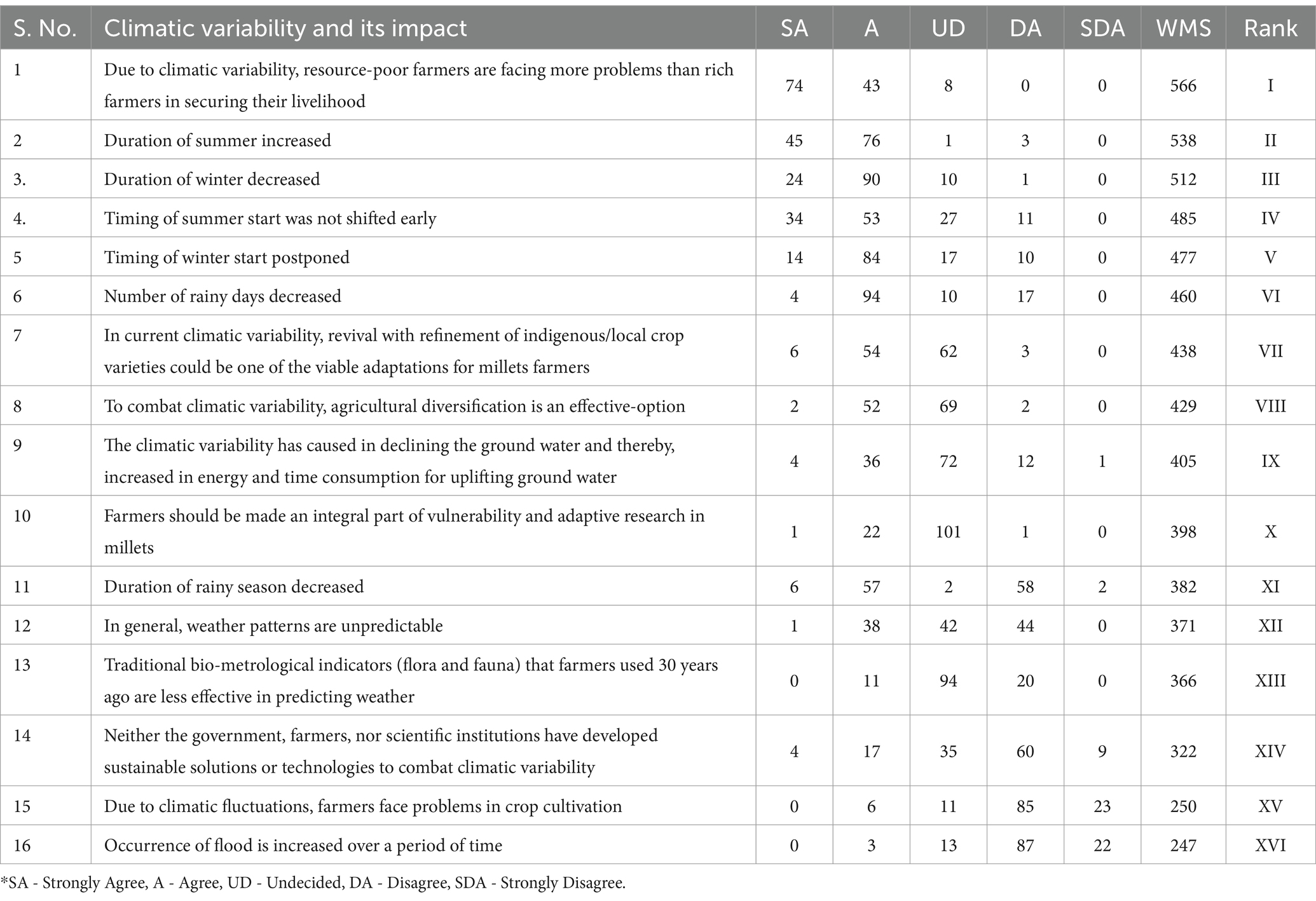
Table 4. Farmer’s perception of climatic variability and their needs in agriculture including millets cultivation.
“In the context of current climatic variability, revival of indigenous/local crop varieties, could be one of the viable adaptations for millets farmers” was suggested on seventh rank (WMS = 438). “To combat climatic variability, agricultural diversification is an effective-option” was ranked eighth (WMS = 429). The tribes’ perceptions of climate change and the deterioration of natural resources included decreased rainfall, rainy days, higher temperatures throughout the agricultural season, greater rainfall during harvest, loss of topsoil, decreased stream flow, and surface flow (Prakash et al., 2020). Varadan and Kumar (2015) in their study suggested that some adaptation tactics such as creating new crop types, early weather warning systems, agricultural resource management approaches, dynamic crop insurance, and income stability programs shift in order to combat the negative effects of climate change. According to Moyo et al. (2012) and Mavhura et al. (2022), agro-forestry, mixed farming, soil moisture conservation, and agricultural diversification are effective measures against climate change. “The climatic variability has caused declining the groundwater and thereby, increased in energy and time consumption for uplifting groundwater” was ranked ninth (WMS = 405). In addition to the previous findings, “farmers should be made an integral part of vulnerability and adaptive research in millets” ranked tenth (WMS = 398) among the suggestions. Mamba (2016) in his study advised that any policy aimed at helping farmers understand climate variables rainfall in particular should take into account the many years of farming experience of older farmers, as they have certain skills and indigenous knowledge that help them perceive accurately relative to their younger counterparts, peers, or younger farmers. “Duration of rainy season decreased” was also realized on ranked eleventh (WMS = 382). Similar studies also noted that respondents believed that climate change caused an increase in mean temperature and a decrease in yearly rainfall (Bewket, 2012; Bewket and Alemu, 2011; Varadan et al., 2017).
In general, weather patterns are unpredictable was ranked 12th (WMS = 371). Supporting this, Hussain et al. (2020) reported that the frequency and severity of natural shocks have increased in recent years. “Traditional bio-metrological indicators (flora and fauna) that farmers used 30 years ago are less effective in predicting weather” and “neither the government, farmers, nor scientific institutions have developed sustainable solutions or technologies to combat climatic variability” were ranked 13th (WMS = 366) and 14th (WMS = 322), respectively. Building irrigation infrastructure can help tribal farmers become more economically secure, improve their food security, and create jobs (Ngcamu and Chari, 2020). Thus, strengthening farmers’ resilience may benefit more from a systems approach. “Due to climatic fluctuations, farmers face problems in crop cultivation” was ranked 15th (WMS = 250). Crop yield reduction in coastal areas was thought to be the largest effect of climate change (Palanisami et al., 2009). The Zimbabwe National Statistical Agency (2017) also noted the decrease in yield. Farmers in Southern Africa most frequently noticed this climate effect. For instance, farmers in South Africa’s Gauteng, Limpopo, and Mpumalanga regions experienced considerable crop yield losses as a result of climate change (Elum et al., 2017). Similarly, smallholder farmers in Zimbabwe’s Chirumanzu district stated that the main effect of climate variability and changes was lower crop yields (Manyani et al., 2017). Similar views were also noted in Tanzania and Uganda (Kangalawe et al., 2017; Okonya et al., 2013). As per the farmer’s opinion, “Occurrence of flood is increased over a period of time” was ranked 16th (WMS = 247). Respondents noted a rise in both the frequency and intensity of extreme weather events (drought and flood) over time as stated by Tessema and Simane, 2021. Based on the data, tribal farmers understand the effects of climate variability and how to adapt to modern agricultural practices, including the cultivation of millets. Varadan and Kumar (2014) also reported that the majority of the farmers experienced climate change effects farming. Similarly, Sanfo et al. (2014) in his study reported that about 65% of the farmers explained that the climate has changed and this is experienced as lesser rain and dry spells. Farmers’ experiences with previous climatic events, such as droughts or floods, deeply shape their understanding of climatic variability. Those with a history of coping with extreme weather events are often more attuned to gradual shifts in climate and can better recognize patterns. Personal attitudes toward risk, innovation, and new farming practices also impact how farmers respond to climate variability. More conservative farmers may prefer to stick to traditional methods even under changing climatic conditions, while others may be open to experimenting with new seeds, planting techniques, or crop diversification especially, those had good exposure, experience and are innovative.
3.4 Relationship between independent variables and farmer’s perception of climate variability
The correlation analysis of the selected independent variables obtained with farmer’s perception of climate variability is presented in Table 5. Out of the 13 independent variables, only two variables viz., social participation was found to be significant at a 5% level of significance and mass media use was found to be significant at a 1% level of significance. It is revealed that knowledge sharing and resources within community or village networks enabled the farmers to understand environmental shocks. Informal and communication networks helped the farmers exchange information about precautions to be taken and other adaptation techniques. The remaining 11 variables, viz., age, education, sex, family size, land holding, the area under millet, experience in millet cultivation, annual income, livestock population, the impact of climate change, and decision-making were found to be non-significant. It is therefore concluded that farmers who accessed various mass media channels were able to recognize the impact of climate variability on their livelihoods. The variable that has a significant correlation with the dependent variable and can be influenced. The mass media usage should be manipulated by making farmers well-versed about the recent ICT technologies that provide information with the latest climate change knowledge and adaptation skills so that the farmer’s perception of climate variability can be well understood. The regression analysis (Table 6) showed an R2 value of 0.177, indicating that the 13 selected independent variables explained only 17.70% of the variation in respondents’ perceptions. This suggests that 82.30% of the variation is due to extraneous variables, requiring further in-depth study. It is showed that there is very limited understanding of the climate change and variabilities among the tribal farmers.
3.5 Different components of farmers’ perception of climatic variability and their needs
To interpret the rotated factors (Table 7), only statements with factor loadings of 0.6 or higher were selected (Table 8). Component I accounted for 12.50% of the total data variability. It has one statement named as “Timing of summer season,” which consists of only one statement; i.e., timing of summer start was not shifted early (0.934). Component II accounted for 7.80% of the total data variability. This component was entitled as “Difficulties in farming due to climate variability.” As we could see from the results that due to climatic fluctuations, farmers face problems in crop cultivation (0.799). Component III accounted for 8.28% of total data variability. This component was named as “Postponed onset of winter season.” It consists of one statement timing of winter start is postponed (0.897). Component IV accounted for 10.00% of total data variability. It was entitled as “Increased weather predictability.” This component had only one statement, namely, in general, weather patterns are unpredictable (0.952). Component V accounted for 16.00% of the total data variability. This component was named as “change in rainy season.” It consists of one statement, i.e., duration of rainy season decreased (0.968). Component VI accounted for 11.46% of the total data variability. This component was named as “suggestion to combat climate variability.” It consists of one statement, i.e., neither the government, farmers, nor scientific institutions have developed sustainable solutions or technologies to combat climatic variability (0.948). Tribal communities have bio-resources such as maintaining variety of local millet seeds that are specifically adapted to the microclimates of their regions, and traditional knowledge of the farmers that they use as natural indicators, such as the behavior of birds or changes in plant phenology, to predict seasonal weather patterns, which needs to be validated scientifically. The preservation of these traditional seed varieties is crucial to maintaining biodiversity and ensuring that farmers have resilient options in the face of climatic uncertainty. Ifejika Speranza et al. (2010), Van Huynh et al. (2020), and Manandhar et al. (2011) reported similar findings in their studies, highlighting that income diversification through non-farm activities such as backyard poultry, small ruminant rearing, wage labor, and handicrafts strengthens resilience.
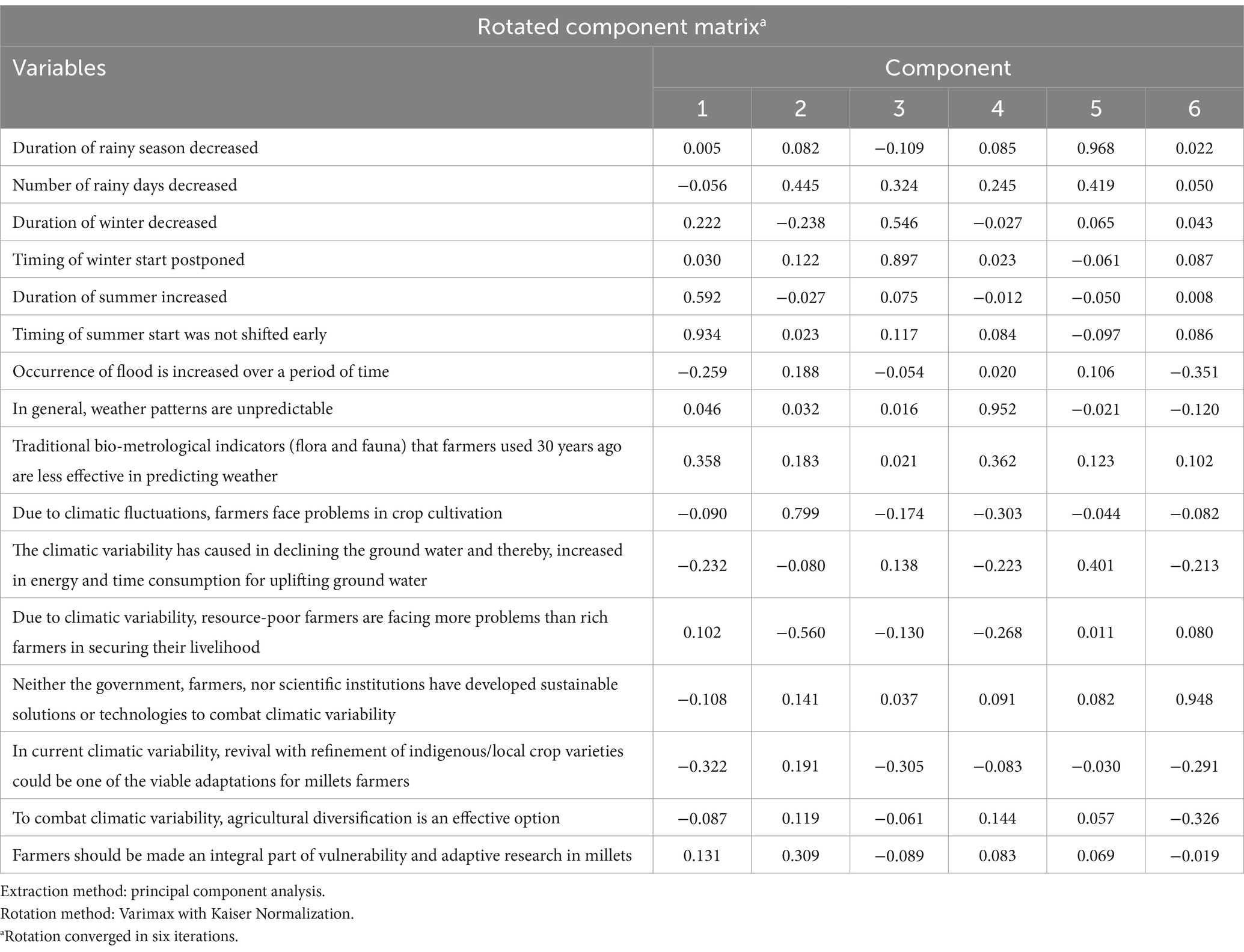
Table 7. Rotated component matrix for climate variability and its effect realized by farmers on agriculture including millet cultivation.
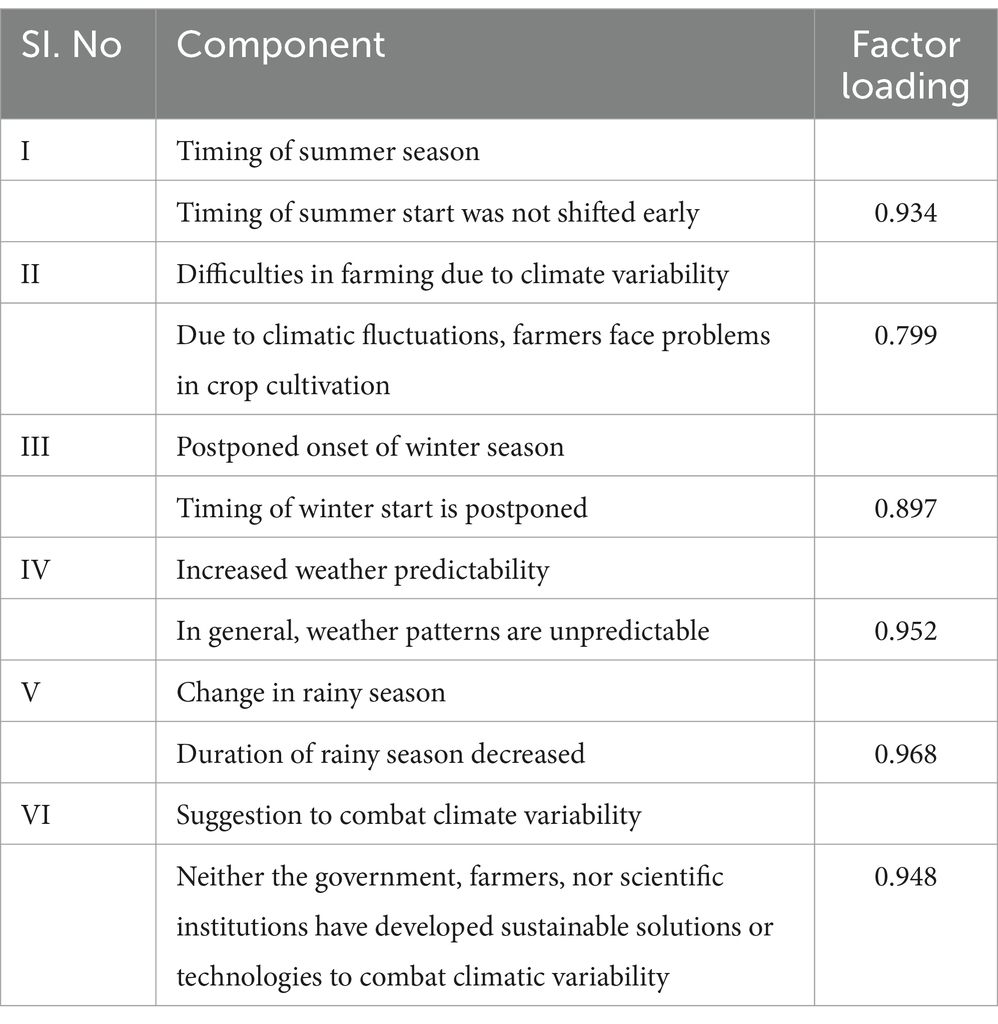
Table 8. Components of perceived climate variability by farmers and their needs in agriculture including millet cultivation.
4 Conclusion
The farmers’ perception of climatic variability in agriculture and millet farming were reflected in their responses as groundwater level depletion, number of rainy days, duration of rainy season, postponed timing of winter, changes in the timing of summer start, unpredictable weather, occurrence of flood, diversification in agriculture, revival of local varieties, crop cultivation problems, livelihood problems, lack of sustainable solutions, and ineffective traditional biological indicators. Their recommendations as farmers must to be incorporated into the overall planning of the research. Their resources for subsistence were being impacted by the lengthening of the dry season, longer dry spells, increased summer temperatures, and shorter rainy seasons. As a result, people were using more energy to raise groundwater and ensure food security. Farmers implemented a variety of crop and land use management techniques in reaction to the perceived changes. In addition to this, crop management techniques such as planting rotation, growing short-season types, and cultivating drought-tolerant crops were also included. The resource-poor farmers really benefited from livestock to maintain their means of subsistence. In addition to the stress of managing climate variability, family’s income was negatively impacted by changes in cropping patterns or the adoption of alternative livelihood activities. It is anticipated that the tribal community will suffer greatly in the future due to the changing environment. In order to maximize revenues, farmers must be urgently trained in adopting improved climate-resilient crop production techniques, such as millets, and how to use inputs appropriately. The findings demonstrate that a combination of socio-economic factors, personal experiences, and agro-ecological practices play a crucial role in shaping farmers’ adaptive strategies to counteract the effects of climate change. Additionally, there is a need for the implementation of stronger and more appropriate government policies, such as weather-based crop selection, timely input support, and crop insurance, to give farmers greater financial support both during and after agricultural losses brought-on by extreme weather events and climate change. Access to government loans, initiatives and subsidies needs to be made better, particularly during periods of harsh weather. Government research and development organizations should take appropriate action to protect farms and preserve natural resources as well as to limit the impact on physio-metrological elements through accurate weather forecasting. Furthermore, the study advocates for the integration of traditional millet farming practices with modern agricultural techniques as well as the need for targeted policies that strengthen institutional support, market access, and capacity-building initiatives for tribal farmers.
Data availability statement
The raw data supporting the conclusions of this article will be made available by the authors, without undue reservation.
Ethics statement
Written informed consent was obtained from the individual(s) for the publication of any identifiable images or data included in this article.
Author contributions
RC: Conceptualization, Methodology, Project administration, Writing – original draft, Writing – review & editing. CS: Supervision, Writing – review & editing. EI: Data curation, Project administration, Writing – review & editing. PL: Data curation, Formal analysis, Writing – review & editing. VP: Data curation, Formal analysis, Writing – review & editing.
Funding
The author(s) declare financial support was received for the research, authorship, and/or publication of this article. Rajendra R. Chapke received funding from ICAR—National Agricultural Science fund (NASF), New Delhi, India, under grant number F. No. NASF/SS-8012/2019–20.
Acknowledgments
The authors thank the farmers who volunteered for the study against various odds. The authors are grateful to the managing authorities of the village for providing the necessary facilities to conduct the study. The authors are grateful to the ICAR—National Agricultural Science Fund (NASF) for funding support to conduct this study.
Conflict of interest
The authors declare that the research was conducted in the absence of any commercial or financial relationships that could not be construed as a potential conflict of interest.
Generative AI statement
The authors declare that no Gen AI was used in the creation of this manuscript.
Publisher’s note
All claims expressed in this article are solely those of the authors and do not necessarily represent those of their affiliated organizations, or those of the publisher, the editors and the reviewers. Any product that may be evaluated in this article, or claim that may be made by its manufacturer, is not guaranteed or endorsed by the publisher.
References
Abid, M., Scheffran, J., Schneider, U. A., and Ashfaq, M. J. E. S. D. (2015). Farmers' perceptions of and adaptation strategies to climate change and their determinants: the case of Punjab province, Pakistan. Earth Syst. Dyn. 6, 225–243. doi: 10.5194/esd-6-225-2015
Affoh, R., Zheng, H., Dangui, K., and Dissani, B. M. (2022). The impact of climate variability and change on food security in sub-saharan africa: perspective from panel data analysis. Sustain. For. 14:759. doi: 10.3390/su14020759
Alston, J. M., and Pardey, P. G. (2014). Agriculture in the global economy. J. Econ. Perspect. 28, 121–146. doi: 10.1257/jep.28.1.121
Amiraslani, F., and Dragovich, D. (2023). Food-energy-water nexus in Iran over the last two centuries: A food secure future? Energy Nexus 10:100189. doi: 10.1016/j.nexus.2023.100189
Antwi-Agyei, P., Abalo, E. M., Dougill, A. J., and Baffour-Ata, F. (2021). Motivations, enablers and barriers to the adoption of climate-smart agricultural practices by smallholder farmers: evidence from the transitional and savannah agroecological zones of Ghana. Reg. Sustain. 2, 375–386. doi: 10.1016/j.regsus.2022.01.005
Awazi, N. P., Quandt, A., and Kimengsi, J. N. (2023). Endogenous livelihood assets and climate change resilience in the Mezam highlands of Cameroon. GeoJournal 88, 2491–2508. doi: 10.1007/s10708-022-10755-9
Ayal, D. Y., and Leal Filho, W. (2017). Farmers' perceptions of climate variability and its adverse impacts on crop and livestock production in Ethiopia. J. Arid Environ. 140, 20–28. doi: 10.1016/j.jaridenv.2017.01.007
Bal, P. K., Ramachandran, A., Geetha, R., Bhaskaran, B., Thirumurugan, P., Indumathi, J., et al. (2016). Climate change projections for Tamil Nadu, India: deriving high-resolution climate data by a downscaling approach using PRECIS. Theor. Appl. Climatol. 123, 523–535. doi: 10.1007/s00704-014-1367-9
Balaganesh, G., Malhotra, R., Sendhil, R., Sirohi, S., Maiti, S., Ponnusamy, K., et al. (2020). Development of composite vulnerability index and district level mapping of climate change induced drought in Tamil Nadu, India. Ecol. Indic. 113:106197. doi: 10.1016/j.ecolind.2020.106197
Batungwanayo, P., Habarugira, V., Vanclooster, M., Ndimubandi, J., Koropitan, F., and Nkurunziza, J. D. D. (2023). Confronting climate change and livelihood: smallholder farmers’ perceptions and adaptation strategies in northeastern Burundi. Reg. Environ. Chang. 23:47. doi: 10.1007/s10113-022-02018-7
Bewket, W. (2012). Climate change perceptions and adaptive responses of smallholder farmers in central highlands of Ethiopia. Int. J. Environ. Stud. 69, 507–523. doi: 10.1080/00207233.2012.683328
Bewket, W., and Alemu, D. (2011). Farmers' perceptions of climate change and its agricultural impacts in the Abay and Baro-Akobo River basins, Ethiopia. Ethiop. J. Dev. Res. 32, 1–28. doi: 10.4314/ejdr.v32i2.68605
Bradshaw, B., Dolan, H., and Smit, B. (2004). Farm-level adaptation to climatic variability and cdhange: crop diversification in the Canadian prairies. Clim. Chang. 67, 119–141. doi: 10.1007/s10584-004-0710-z
Bragg, D. E., Silvia, I. R., John, G., Uma, S., and Abrol, D. P. (2016). “Integrated pest management in tropical cereal crops” in Integrated pest management in the tropics. eds. C. Rapisarda and G. M. Cocuzza (New Delhi: New India Publishing Agency), 249–273.
Bryan, E., Deressa, T. T., and Gbetibouo, G. A. (2009). Adaptation to climate change in Ethiopia and South Africa: options and constraints. Environ. Sci. Pol. 12, 413–426. doi: 10.1016/j.envsci.2008.11.002
Clapp, J. (2020). Food security and nutrition: building a global narrative towards 2030. Rome: HLPE.
Davis, P., and Ali, S. (2014). Exploring local perceptions of climate change impact and adaptation in rural Bangladesh. SSRN Electron. J. 1322:696. doi: 10.2139/ssrn.2405696
Deressa, T. T., Hassan, R. M., and Ringler, C. (2009). Determinants of farmers’ choice of adaptation methods to climate change in the Nile Basin of Ethiopia. Glob. Environ. Chang. 19, 248–255. doi: 10.1016/j.gloenvcha.2009.01.002
Egbe, C. A., Yaro, M. A., Okon, A. E., and Bisong, F. E. (2014). Rural peoples’ perception to climate variability/change in Cross River state-Nigeria. J. Sustain. Dev. 7, 25–36. doi: 10.5539/jsd.v7n2p25
Elum, Z. A., Modise, D. M., and Marr, A. (2017). Farmer’s perception of climate change and responsive strategies in three selected provinces of South Africa. Clim. Risk Manag. 16, 246–257. doi: 10.1016/j.crm.2016.11.001
Funk, C., Sathyan, A. R., Winker, P., and Breuer, L. (2020). Changing climate-changing livelihood: smallholder's perceptions and adaption strategies. J. Environ. Manag. 259:109702. doi: 10.1016/j.jenvman.2019.109702
Gupta, A. K., Negi, M., Nandy, S., Kumar, M., Singh, V., Valente, D., et al. (2020). Mapping socio-environmental vulnerability to climate change in different altitude zones in the Indian Himalayas. Ecol. Indic. 109:105787. doi: 10.1016/j.ecolind.2019.105787
Habiba, U., Shaw, R., and Takeuchi, Y. (2012). Farmer's perception and adaptation practices to cope with drought: perspectives from northwestern Bangladesh. Int. J. Disaster Risk Reduct. 1, 72–84. doi: 10.1016/j.ijdrr.2012.05.004
He, F., Thiele, B., Santhiraraja-Abresch, S., Watt, M., Kraska, T., Ulbrich, A., et al. (2020). Effects of root temperature on the plant growth and food quality of Chinese broccoli (Brassica oleracea var. alboglabra bailey). Agronomy 10:702. doi: 10.3390/agronomy10050702
Hussain, A., Memon, J. A., and Hanif, S. (2020). Weather shocks, coping strategies and farmers’ income: A case of rural areas of district Multan, Punjab. Weather Clim. Extrem. 30:100288. doi: 10.1016/j.wace.2020.100288
Ifejika Speranza, C., Kiteme, B., Ambenje, P., Wiesmann, U., and Makali, S. (2010). Indigenous knowledge related to climate variability and change: insights from droughts in semi-arid areas of former Makueni District, Kenya. Clim. Change 100, 295–315. doi: 10.1007/s10584-009-9713-0
IPCC (2022). Climate change 2022: impacts, adaptation, and vulnerability. Contribution of working group II to the sixth assessment report of the intergovernmental panel on climate change. Cambridge, UK and New York, NY, USA: Cambridge University Press.
Josef, S., and Tubiello, N. F. (2007). Global food security under climate change. Proc. Natl. Acad. Sci. 104, 19703–19708. doi: 10.1073/pnas.0701976104
Kalita, H. (2017). Impact of MGNREGA on the living condition of rural poor-a study in Barpeta and Marigaon districts of Assam. Assam: University of Gowhati.
Kangalawe, R. Y., Mung’ong’o, C. G., Mwakaje, A. G., Kalumanga, E., and Yanda, P. Z. (2017). Climate change and variability impacts on agricultural production and livelihood systems in Western Tanzania. Clim. Dev. 9, 202–216. doi: 10.1080/17565529.2016.1146119
Kogo, B. K., Kumar, L., and Koech, R. (2021). Climate change and variability in Kenya: a review of impacts on agriculture and food security. Environ. Dev. Sustain. 23, 23–43. doi: 10.1007/s10668-020-00589-1
Lone, F. A., Maheen, M., Ul Shafiq, M., Bhat, M. S., and Rather, J. A. (2020). Farmer’s perception and adaptation strategies to changing climate in Kashmir Himalayas, India. GeoJournal 87, 1743–1757. doi: 10.1007/s10708-020-10330-0
Maja, M. M., and Ayano, S. F. (2021). The impact of population growth on natural resources and farmers’ capacity to adapt to climate change in low-income countries. Earth Syst. Environ. 5, 271–283. doi: 10.1007/s41748-021-00209-6
Mamba, S. F. (2016). Factors influencing perception of climate variability and change among smallholder farmers in Swaziland. Indian J. Nutr. 3, 138–142.
Manandhar, S., Vogt, D. S., Perret, S. R., and Kazama, F. (2011). Adapting cropping systems to climate change in Nepal: a cross-regional study of farmers’ perception and practices. Reg. Environ. Chang. 11, 335–348. doi: 10.1007/s10113-010-0137-1
Manyani, A., Chagweda, K., Muzenda-Mudavanhu, C., and Chanza, N. (2017). Indigenous-based practices of adapting to climate change: reflections from Chirumhanzu, Zimbabwe. IOSR-JESTFT 11, 54–66. doi: 10.9790/2402-1112015466
Mavhura, E., Manyangadze, T., and Aryal, K. R. (2022). Perceived impacts of climate variability and change: an exploration of farmers’ adaptation strategies in Zimbabwe’s intensive farming region. GeoJournal 87, 3669–3684. doi: 10.1007/s10708-021-10451-0
Mishra, A., Singh, J., Maurya, A. S., and Malik, J. S. (2021). Effect of socio-personal traits of farmers on their perception towards social media. Indian J. Ext. Educ. 57, 71–74. doi: 10.48165/IJEE.2021.57416
Moroda, G. T., Tolossa, D., and Semie, N. (2018). Perception and adaptation strategies of rural people against the adverse effects of climate variability: A case study of Boset District, east Shewa, Ethiopia. Environ. Dev. 27, 2–13. doi: 10.1016/j.envdev.2018.07.005
Moyo, M., Mvumi, B. M., Kunzekweguta, M., Mazvimavi, K., Craufurd, P., and Dorward, P. (2012). Farmer perceptions on climate change and variability in semi-arid Zimbabwe in relation to climatology evidence. Afr. Crop. Sci. J. 20, 317–335.
Mugabe, P., Kipkulei, H., Sieber, S., Mhache, E., and Löhr, K. (2024). Examining climate trends and patterns and their implications for agricultural productivity in Bagamoyo District, Tanzania. Front. Clim. 6:1346677. doi: 10.3389/fclim.2024.1346677
Muzari, W., Muvhunzi, S., Soropa, G., and Kupika, O. L. (2014). Impacts of climate variability and change and farmers’ responsiveness in the agricultural sector in Zimbabwe. Int. J. Sci. Res. 3, 1726–1731.
Ngcamu, B. S., and Chari, F. (2020). Drought influences on food insecurity in Africa: a systematic literature review. Int. J. Environ. Res. Public Health 17:5897. doi: 10.3390/ijerph17165897
Okonya, J. S., Syndikus, K., and Kroschel, J. (2013). Farmers' perception of and coping strategies to climate change: evidence from six agro-ecological zones of Uganda. J. Agric. Sci. 5:252. doi: 10.5539/jas.v5n8p252
O'Neill, B. C., van Aalst, M., Zaiton Ibrahim, Z., Berrang-Ford, L., Bhadwal, S., Buhaug, H., et al. (2022). “Key risks across sectors and regions” in Climate change 2022: impacts, adaptation and vulnerability. Contribution of working group II to the sixth assessment report of the intergovernmental panel on climate change. eds. A. Mirzabaev, A. Thomas, and R. Warren (Cambridge: Cambridge University Press).
Palanisami, K., Paramasivam, P., Ranganathan, C. R., Aggarwal, P. K., and Senthilnathan, S. (2009). “Quantifying vulnerability and impact of climate change on production of major crops in Tamil Nadu, India” in Headwaters to the ocean–hydrological change and watershed management. eds. M. Taniguchi, W. C. Burnett, Y. Fukushima, M. Haigh, and Y. Umezawa (London: Taylor and Francis), 509–551.
Pavithrapriya, S., Ramachandran, A., Ahamedibrahim, S., and Palanivelu, K. (2022). Climate variability trend and extreme indices for the Thanjavur Delta region of Tamil Nadu in South India. Mausam 73, 237–250. doi: 10.54302/mausam.v73i2.5475
Prakash, R. J., Damodar, J., and Nibal, D. (2020). Community perceptions on climate change and natural resources degradation in a tribal context: an empirical study in Koraput, Odisha. Disaster Adv. 13, 9–13.
Raghuvanshi, R., and Ansari, M. A. (2020). Farmers’ vulnerability to climate change: A study in north Himalayan region of Uttarakhand, India. Indian J. Exten. Educ. 56, 1–8.
Sahu, A., and Badoghar, A. K. (2011). A study on low literacy among three dominated tribes of Koraput, Odisha (India). Gyanodaya 4, 67–72.
Sanfo, S., Lamers, J., Mueller, M., and Fonta, W., (2014). Farmers’ perception of climate change and climate variability versus climatic evidence in Burkina Faso, West Africa. In Proceedings of the Climate Change in Africa. Negotiations, Translations, and Socio-Political Implications, Bonn, Germany. 10–12.
Swaminathan, M. S. (2015). In search of biohappiness: Biodiversity and food, health and livelihood security. Singapore: World Scientific.
Tessema, I., and Simane, B. (2021). Smallholder farmers’ perception and adaptation to climate variability and change in Fincha sub-basin of the upper Blue Nile River basin of Ethiopia. GeoJournal 86, 1767–1783. doi: 10.1007/s10708-020-10159-7
Van Huynh, C., Le, Q. N. P., Nguyen, M. T. H., Tran, P. T., Nguyen, T. Q., Pham, T. G., et al. (2020). Indigenous knowledge in relation to climate change: adaptation practices used by the xo dang people of Central Vietnam. Heliyon 6:e05656. doi: 10.1016/j.heliyon.2020.e05656
Varadan, R. J., and Kumar, P. (2014). Indigenous knowledge about climate change: validating the perceptions of dryland farmers in Tamil Nadu. Indian J. Tradit. Knowl. 13, 390–397.
Varadan, R. J., and Kumar, P. (2015). Mapping agricultural vulnerability of Tamil Nadu, India to climate change: A dynamic approach to take forward the vulnerability assessment methodology. Clim. Chang. 129, 159–181. doi: 10.1007/s10584-015-1327-0
Varadan, R. J., Kumar, P., Jha, G. K., Pal, S., and Singh, R. (2017). An exploratory study on occurrence and impact of climate change on agriculture in Tamil Nadu, India. Theor. Appl. Climatol. 127, 993–1010. doi: 10.1007/s00704-015-1682-9
Yang, L., and Hamori, S. (2023). Modeling the global sovereign credit network under climate change. Int. Rev. Financ. Anal. 87:102618. doi: 10.1016/j.irfa.2023.102618
Yeleliere, E., Antwi-Agyei, P., and Guodaar, L. (2023). Farmers response to climate variability and change in rainfed farming systems: insight from lived experiences of farmers. Heliyon 9:e19656. doi: 10.1016/j.heliyon.2023.e19656
Zimbabwe National Statistical Agency (2017). Inter-Censal Demographic Survey 2017 [online]. Available at: https://www.zimstat.co.zw.
Keywords: adaptation, climate change, climate vulnerability, farmers perception, livelihood, millets, tribal farmers
Citation: Chapke RR, Satyavathi CT, Israel Oliver King ED, Laxmiprasanna P and Priyanka V (2025) Perceptions of climatic variability among millet farmers: insights from tribal communities in the Kolli Hills, Tamil Nadu, South India. Front. Clim. 6:1506084. doi: 10.3389/fclim.2024.1506084
Edited by:
Pradeep K. Dubey, International Rice Research Institute South Asia Regional Centre, IndiaReviewed by:
Silvia Francis Materu, Sokoine University of Agriculture, TanzaniaShubham Pathak, Walailak University, Thailand
Copyright © 2025 Chapke, Satyavathi, Israel Oliver King, Laxmiprasanna and Priyanka. This is an open-access article distributed under the terms of the Creative Commons Attribution License (CC BY). The use, distribution or reproduction in other forums is permitted, provided the original author(s) and the copyright owner(s) are credited and that the original publication in this journal is cited, in accordance with accepted academic practice. No use, distribution or reproduction is permitted which does not comply with these terms.
*Correspondence: Rajendra R. Chapke, Y2hhcGtlQG1pbGxldHMucmVzLmlu
 Rajendra R. Chapke
Rajendra R. Chapke C. Tara Satyavathi
C. Tara Satyavathi E. D. Israel Oliver King2
E. D. Israel Oliver King2 Peddiveeti Laxmiprasanna
Peddiveeti Laxmiprasanna Vavilala Priyanka
Vavilala Priyanka

